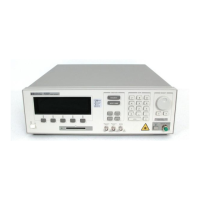2
Using the Internal Modulation
The internal modulating source is a square wave with a 50% duty-cycle.You can
set both the amplitude and the frequency of this signal. The amplitude is set by
the power parameter. This is the maximum output power of the output signal;
at the minimum, nothing is output.
Figure 2-8. The Modulated Signal
Setting the Output Power of a Modulated Signal
You can set the output power of a modulated signal if the display looks like this:
Figure 2-9. Setting the Output Power of an Internally Modulated Signal
Press
4
OUTPUT POWER
5
,
NNNNNNNNNNNNNNNNNNNN
Mod/CW
, and
NNNNNNNNNNN
Int
as necessary to get to this display.
See \Changing the Value of a Parameter" in Chapter 1 if you need details on
how to edit parameters.
You can change the units by pressing
NNNNNNNNNNNNNNNNN
W/dBm
.
The notes above about excessive power, and the analog output apply also to the
power of a modulated signal.
Setting the Frequency of a Modulated Signal
You can also set the frequency of a modulated signal from the display shown
above. Press
N
NNNNNNNNNNNNN
Freq
to select the parameter. See \Changing the Value of a
Parameter" in Chapter 1 if you need details on how to edit parameters.
You can change the units by pressing
NNNNNNNNNNNNNNNNNNNN
Hz/kHz
while you are editing the value.
The new units come into eect when you press
4
ENTER
5
.
Setting Wavelength and Power 2-11

